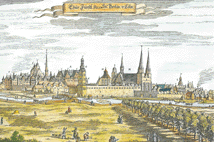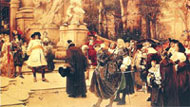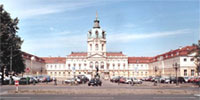History
Earliest Settlement
 When
the glaciers receded northwards across Europe after the last Ice
Age, they left a vast flat sandy plain through which rivers meandered
aimlessly to the Baltic. On the northern bank and on an island
in one of these rivers - the Spree - the twin settlements of Cölln
and Berlin emerged sometime in the 12th Century. The inhabitants
were primarily fishermen, but could further take advantage of
trade between the Hansa merchants of the North Sea and Baltic,
and the ore mountains of Bohemia to the south. They were also
well placed to exploit trade between other parts of the Holy Roman
Empire to the South-West and the lands to the East, plundered
for furs, grain and timber by German knights. When
the glaciers receded northwards across Europe after the last Ice
Age, they left a vast flat sandy plain through which rivers meandered
aimlessly to the Baltic. On the northern bank and on an island
in one of these rivers - the Spree - the twin settlements of Cölln
and Berlin emerged sometime in the 12th Century. The inhabitants
were primarily fishermen, but could further take advantage of
trade between the Hansa merchants of the North Sea and Baltic,
and the ore mountains of Bohemia to the south. They were also
well placed to exploit trade between other parts of the Holy Roman
Empire to the South-West and the lands to the East, plundered
for furs, grain and timber by German knights.
The Great Elector and the Hohenzollern Dynasty
Through the Middle Ages this valuable trade and the two towns,
which later merged to bear the name Berlin, were dominated by
a succession of powerful local families, beginning with the Askaniers,
and in 1415 falling into the hands of the Hohenzollern dynasty,
whose Kurfürst was one of the Electors responsible for choosing
the Holy Roman Emperor. As the administrative centre of the new princedom, Berlin survived
plague and the Thirty Years War, but it stagnated economically
and its fortunes didn't revive till 1640, when Friedrich Wilhelm,
"The Great Elector " ascended to the throne. The young
ruler cleaned up the city, and the population expanded rapidly
as he invited waves of immigrants - agricultural specialists from
the Netherlands, Jewish merchants and bankers recently expelled
from Vienna, Protestant refugees from Poland, tradesmen from Italy,
and, as a result of the Edict of Potsdam in 1685, 6,000 Huguenot
refugees from France. Commerce and industry boomed, the Rivers
Oder and Spree were linked with a canal, and a 30,000 strong professional
army was created.
As the administrative centre of the new princedom, Berlin survived
plague and the Thirty Years War, but it stagnated economically
and its fortunes didn't revive till 1640, when Friedrich Wilhelm,
"The Great Elector " ascended to the throne. The young
ruler cleaned up the city, and the population expanded rapidly
as he invited waves of immigrants - agricultural specialists from
the Netherlands, Jewish merchants and bankers recently expelled
from Vienna, Protestant refugees from Poland, tradesmen from Italy,
and, as a result of the Edict of Potsdam in 1685, 6,000 Huguenot
refugees from France. Commerce and industry boomed, the Rivers
Oder and Spree were linked with a canal, and a 30,000 strong professional
army was created.
Crooked Fritz
The Elector's successor, "Crooked Fritz", was a spendthrift ruler
obsessed with the desire to be crowned King of Prussia, which
he achieved at the cost of  bankrupting
the city. Nonetheless his reign saw the further growth of the
city, including the building the suburbs - Dorotheenstadt and
Friedrichstadt, north and south of Unter den Linden, the avenue
that led from the palace, westwards to the hunting park which
is now Tiergarten. His second wife, Sophie Charlotte, was a highly
cultured woman and attracted philosophers, like Leibniz, to the
city, and artists, like the sculptor Schlüter or architects Nering
and Eosander, who were commissioned to build a palace for her.
Around this palace, "Schloss Charlottenburg", developed
the suburb Charlottenburg, now a city district. bankrupting
the city. Nonetheless his reign saw the further growth of the
city, including the building the suburbs - Dorotheenstadt and
Friedrichstadt, north and south of Unter den Linden, the avenue
that led from the palace, westwards to the hunting park which
is now Tiergarten. His second wife, Sophie Charlotte, was a highly
cultured woman and attracted philosophers, like Leibniz, to the
city, and artists, like the sculptor Schlüter or architects Nering
and Eosander, who were commissioned to build a palace for her.
Around this palace, "Schloss Charlottenburg", developed
the suburb Charlottenburg, now a city district.
 The
Soldier King The
Soldier King
The next Friedrich, nicknamed "The Soldier King", imposed an iron
regime over the city, paying off his father's debts, creating
a guard regiment of giants, expanding the army and turning it
into the most modern in the world, famous for its coordinated
infantry drill manoeuvres.
 Frederick
the Great Frederick
the Great
In 1740 the Crown Prince Friedrich succeeded his father. Friedrich
the Great combined a passionate interest in the arts - Knobelsdorff's
Opera House and Sans Souci palace in Potsdam were built in this
period - with an expansionist foreign policy, extending the Hohenzollern
Kingdom to include parts of Silesia, West Prussia, Saxony and
Bohemia, and provoking the power struggle with the Austrian Empire
which was to continue into the next century. Although Berlin benefitted
from its new world city status and the growth of the textile and
metalworking industries, which serviced the army of 150,000, its
citizens were taxed mercilessly, and despite the absence of censorship,
the state was despotic, with an arrogant monarch and secret police.
The Growth of Nationalism and
Revolt
Prussia's defeat by Napoleon was partly responsible for the growth
in German nationalism that followed the French defeat at Waterloo.
Berlin's first university was founded and its centre once again
transformed, this time by the work of Schinkel, the architect
who drew up the plans for the "Neue Wache" and the "Schloss
Brücke" or bridge over the Spree. But the post-war atmosphere
of repression led to a number of abortive attempts to overthrow
the Prussian monarchs, including the 1848 uprising in Berlin when
the citizens erected barricades throughout the city.
The Industrial Revolution
And the city itself was changing for other reasons. The Industrial
Revolution was heralded in by the introduction by British engineers
of steam power for factories and transportation, but very soon
local engineers like August Borsig were commandeering the production
of locomotives, Werner Siemens founded an electrical engineering
company, and the north side of the city became densely packed
with factories and foundries, such as the AEG Turbinenhalle.
 Bismarck
and the Modern City Bismarck
and the Modern City
By 1845 the population had expanded to 400,000 as the city sucked
in workers to run the new plants. Housed in "Mietkaserne" - rent
barracks, living and sanitary conditions were terrible for the
new arrivals, though through regulations implemented, first by
Hinckeldey, the President of Police, and then through Bismarck,
"the Iron Chancellor", slowly fire services, sewage disposal,
piped water, and even a social welfare system were introduced,
even if cynics suggested that these measures were intended to
keep the working population from disturbing the status quo.
A United Germany
After Prussia's victory over the Austrians in 1866 and the French
in 1871, it was in a position to assume control over all of Germany,
and Wilhelm I was proclaimed Emperor of united Germany, finishing
the work commenced with the introduction of an all-German customs
union 37 years earlier. The new Empire suffered from an inferiority
complex having been left far behind in the competition for overseas
colonies, and an incompetent foreign policy combined with the
battle for markets between the industrialised nations of Europe
set the stage for the 1914-1918 War.
The Great War and the Golden
Twenties
In Berlin opposition to the war grew rapidly, and after the Armistice,
chaos reigned - a mutiny of the fleet in Kiel, the abdication
of the Kaiser, the simultaneous declaration of 2 competing republics
in Berlin and three months of street-fighting in the capital.
Eventually Berliners had their first ever taste of democracy as
Friedrich Ebert was elected President of the Weimar Republic,
and the city enjoyed the Golden Era of the Twenties - Cabaret
on the Ku'damm, films made at Babelsberg by Pabst and Lang, theatre
by Reinhardt and Brecht, the modern art movement known as Dada,
orchestral music composed by Berg and directed by Klemperer.
The Crash and the Rise of the
National Socialists
But the economic and political instability of the new republic
was clear. Hyperinflation in 1923 was followed by the Crash in
1929, and by 1932 Berlin alone had 636,000 unemployed. The tiny
National Socialist Worker's Party had been systematically exploiting
the crises through the 20s and when the Social Democrat government
collapsed in 1930, it stepped into the gap. By 1932 they had won
the national elections and a year later Hitler became Chancellor,
though Berlin itself had voted three to one against the Nazis.
Through the 30s the sickening events unfolded. The flight of artists
and those wealthier Jewish families that could afford it, the
burning of the books on Bebelplatz, supervised by Goebbels, Minister
for Propaganda, the attacks on Jewish property culminating in
"Kristallnacht", the race laws, the construction of the first
concentration camps, the invasion of Czechoslovakia, the dithering
of the British and French governments, and eventually, the invasion
of Poland and the outbreak of war.
The Second World War and Defeat
With far greater air power, and an arms industry that had been
long prepared, the German armies initially swept the field, with
victories in France, North Africa, North-Western and Eastern Europe.
But as America was drawn into the war, with the defeat by the
Russians at Stalingrad and of Rommel in North Africa, and after
the D-Day landings, it became clear that Hitler's days were numbered.
He committed suicide on 30th April 1945, leaving a city defended
by pensioners and nine year olds facing a Russian army of 1.5
million. 11 square miles of the city had been reduced to rubble,
over half a million homes were destroyed, out of a Jewish population
of 160,000, only 6,500 remained in Berlin, the rest living in
exile, deported, gassed or worked to death, more than half a million
civilians had died in bombing raids, of disease, starvation, or
had been drowned in the underground (U-Bahn) tunnels when the
SS dynamited the system to prevent the Russians using them to
capture the City Centre.
It seemed impossible the City which
had had a pre-war population of 4 million people could - should?
- survive. But somehow, out of the ashes grew a new, more civilised
city
For the development of Post-War Germany and Berlin, see Politics.
© 2002-2003 Berlin Travel Service - A1 Design All rights reserved.
|